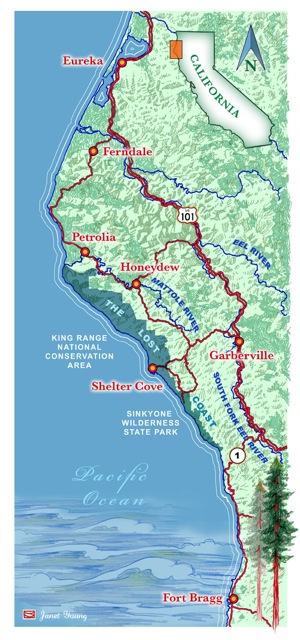Lost Coast Info & Resources

Rising directly out of the Pacific Ocean, Northern California’s wild and rugged Lost Coast area was formed by the dynamic forces of geology, weather and ocean currents.
Tectonic plates and earthquakes continue to uplift the land, while weather erodes and shapes it, giving the area its unique geology and terrain. Because of this rugged topography, builders of the coastal highway were forced to turn inland. And because strong ocean currents in the area rendered navigation difficult, the area became fondly known as The Lost Coast.
Today, the King Range National Conservation Area, Mattole River Valley, Sinkyone Wilderness State Park and adjacent lands comprise the Lost Coast, providing habitat for a diversity of flora and fauna, including coast redwoods. Camping, hiking, backpacking (along with mountain biking and horseback riding in the King Range) are wonderful ways to experience remote places. Fishing and lodging are available in the community of Shelter Cove, and winding mountain roads take you to the Sinkyone Wilderness in the south and to the mouth of the Mattole and Lost Coast Trail in the north.
Lost Coast Area Resources
- King Range National Conservation Area
- Sinkyone Wilderness State Park
- Lost Coast Headlands
- Marine Protected Areas of the Lost Coast
- Tribal Protected Areas of the Lost Coast
- Cape Mendocino Lighthouse
- Rocks & Islands Wilderness
- Lost Coast Redwoods
- CA Coastal National Monument
- BLM National Conservation Lands System
- Lost Coast Tide Chart (Online) and PDF of Lost Coast Tide Guide
- The Lost Coast Trail on AllTrails
- King Range Campgrounds & Trails Fact Sheet
- King Range Mountain Biking Trails
- Tolkan Terrain Park
- Sinkyone Wilderness State Park Brochure
- Shelter Cove Nature & Fitness Trail
- Lost Coast Trail Shuttle Information & Guided Tours
Stay Connected With FOLC
Subscribe to our newsletter to stay up to date with our work and events!
